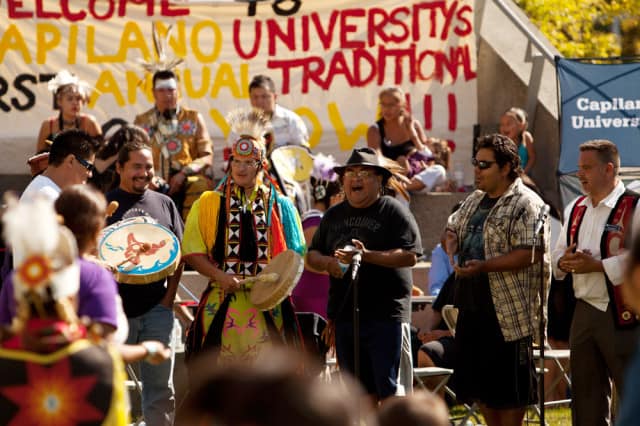MICKI COWAN
CUP B.C. Bureau Chief

The first-ever powwow was held recently at Capilano University in North Vancouverp as a way to expose the community to First Nations culture.
VANCOUVER (CUP) — The British Columbia provincial government announced this summer its plans for increasing aboriginal involvement in post-secondary institutions — a much-need move, says one First Nations post-secondary student liaison.
The Aboriginal Post-Secondary Action Plan outlines goals and objectives to increase aboriginal involvement at higher education institutes across B.C. until 2020.
The plan includes $16.2 million in financial assistance for aboriginal students this year along with funds for a handful of other initiatives. Most of the money will go towards creating partnerships between post-secondary institutions and aboriginal communities, as well as implementing programs and activities as part of Aboriginal Service Plans. Some funding also goes towards emergency financial assistance and award funding.
First Nations liaison of the Capilano University students’ union Dolly Reno said it’s good the government is doing more but that it shouldn’t require so much red tape to get things done.
Though she is from the Mi’kmaq First Nation in Nova Scotia, she is most familiar with West Coast traditions. She organized a powwow at Capilano on Sept. 13 as a way to expose the community to First Nations culture.
“Originally I was planning a typical speakers’ series and have people speak about the culture and have some artists come in,” Reno said. “Half way through the planning I thought that was kind of boring. I don’t want to talk about the culture, so why don’t I just bring the culture here?”
While her powwow was a success, she said that’s not always the case for those organizing First Nations events.
“I know of people that have tried to [host] other cultural celebrations and then been told, ‘No, sorry, you can’t do that,” Reno said. “We can only go so far and then we hit a wall.”
Shirley Hardman, the senior advisor on Indigenous Affairs at the University of the Fraser Valley in Chilliwack, said finding alternative ways of offering First Nations post-secondary education is imperative.
Hardman recently helped organize an event called “Indigenizing the Academy.” The event gathered teams from 33 colleges and universities across the province to discuss how to make sure that indigenous culture and values are integrated into all levels of university, not just confined to specialized classes.
As a Shxwhá:y village band member, Hardman said that working with the aboriginal community to discover what aboriginal post-secondary education should look like — rather than institutions making curriculum decision without input — has been a crucial step in the last ten years.
But part of the challenge facing both grassroots movements and provincial initiatives is getting people to accept new ways of approaching First Nations education.
“The initiatives have really been gung-ho in the past 15 years. But anyone who was educated prior to that wasn’t educated in the same way; the initiatives aren’t fully embraced by all segments of society,” Hardman said. “That’s probably one of the biggest challenges.”
While there is still a lot of work to do to improve aboriginal post-secondary education, the government programs have been making a difference, Hardman said.
The Ministry of Advanced Education provided $600,000 to the building of a new log house at UFV’s Chilliwack campus three years ago as part of a province-wide initiative to create First Nations gathering spaces.
Reno hopes the increased opportunities for post-secondary aboriginal students will generate more graduates.
“For aboriginal people, a lot of the doors have been closed before, or how to navigate post-secondary is not immediately clear when you don’t have a role model there before you to guide you,” she said.
“Now it’s about opening those doors and securing those places.”
—
Photo: Wayne Perkins/Capilano Universioty